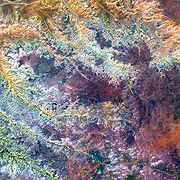
VNIR
Encyclopedia

Electromagnetic spectrum
The electromagnetic spectrum is the range of all possible frequencies of electromagnetic radiation. The "electromagnetic spectrum" of an object is the characteristic distribution of electromagnetic radiation emitted or absorbed by that particular object....
having wavelength
Wavelength
In physics, the wavelength of a sinusoidal wave is the spatial period of the wave—the distance over which the wave's shape repeats.It is usually determined by considering the distance between consecutive corresponding points of the same phase, such as crests, troughs, or zero crossings, and is a...
s between approximately 400 and 1400 nanometers (nm). It combines the full visible spectrum
Visible spectrum
The visible spectrum is the portion of the electromagnetic spectrum that is visible to the human eye. Electromagnetic radiation in this range of wavelengths is called visible light or simply light. A typical human eye will respond to wavelengths from about 390 to 750 nm. In terms of...
with an adjacent portion of the infrared
Infrared
Infrared light is electromagnetic radiation with a wavelength longer than that of visible light, measured from the nominal edge of visible red light at 0.74 micrometres , and extending conventionally to 300 µm...
spectrum
Spectrum
A spectrum is a condition that is not limited to a specific set of values but can vary infinitely within a continuum. The word saw its first scientific use within the field of optics to describe the rainbow of colors in visible light when separated using a prism; it has since been applied by...
up to the water absorption
Water absorption
During the transmission of electromagnetic radiation through a medium containing water molecules, portions of the electromagnetic spectrum are absorbed by water molecules...
band between 1400 and 1500 nm.
Some definitions also include the short-wavelength infrared band from 1400 nm up to the water absorption band at 2500 nm.
VNIR multi-spectral image
Multi-spectral image
A multispectral image is one that captures image data at specific frequencies across the electromagnetic spectrum. The wavelengths may be separated by filters or by the use of instruments that are sensitive to particular wavelengths, including light from frequencies beyond the visible light range,...
cameras have wide applications in remote sensing
Remote sensing
Remote sensing is the acquisition of information about an object or phenomenon, without making physical contact with the object. In modern usage, the term generally refers to the use of aerial sensor technologies to detect and classify objects on Earth by means of propagated signals Remote sensing...
and imaging spectroscopy
Imaging spectroscopy
Imaging spectroscopy is similar to color photography, but each pixel acquires many bands of light intensity data from the spectrum, instead of just the three bands of the RGB color model...
.
See also
- Advanced Spaceborne Thermal Emission and Reflection RadiometerAdvanced Spaceborne Thermal Emission and Reflection RadiometerASTER is a Japanese sensor which is one of five remote sensory devices on board the Terra satellite launched into Earth orbit by NASA in 1999...
- Airborne Real-time Cueing Hyperspectral Enhanced ReconnaissanceAirborne Real-time Cueing Hyperspectral Enhanced ReconnaissanceThe Airborne Real-time Cueing Hyperspectral Enhanced Reconnaissance, also known by the acronym ARCHER, is an aerial imaging system that produces ground images far more detailed than plain sight or ordinary aerial photography can....
- Mars Reconnaissance OrbiterMars Reconnaissance OrbiterMars Reconnaissance Orbiter is a NASA multipurpose spacecraft designed to conduct reconnaissance and Exploration of Mars from orbit...
- Near infrared spectroscopyNear infrared spectroscopyNear-infrared spectroscopy is a spectroscopic method that uses the near-infrared region of the electromagnetic spectrum...

